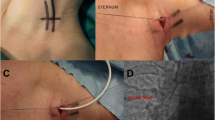Abstract
Background
Cephalic vein (CV) cut down for totally implantable venous access device (TIVAD) placement has been accepted as an alternative to the percutaneous subclavian vein approach. The aim of this retrospective study was to validate the external jugular vein (EJV) cut-down approach when the CV is not feasible.
Methods
Patients receiving a TIVAD from January 1995 to December 2003 were included in this study. Age, sex, surgical technique, disease, device used, length of the procedure, and morbidity were considered.
Results
A total of 427 TIVADs were placed in 425 patients: 253 men (59.5%) and 172 women (40.5%) aged 31 to 79 years. Of 425 patients, 5 were excluded; 420 underwent a CV cut down on the first attempt, and 391 (93.1%) procedures were successful. Among the final 29 patients, 20 (68.96%) underwent a TIVAD placement through the ipsilateral EJV cut-down approach. In the remaining nine patients (31.04%), TIVAD placement was performed through the ipsilateral internal jugular vein in four cases, via the ipsilateral axillary vein in three cases, and through the ipsilateral coracobrachial vein in the other cases. No immediate postoperative complications were detected in any of the patients.
Conclusions
TIVAD placement by the CV cut-down approach is safe and fast, and its success rate is very high. By avoiding the immediate complications associated with the percutaneous approach, the EJV cut down has to be considered a valid, safe, and suitable alternative when the CV is not feasible.
Similar content being viewed by others
References
R Biffi F Braud F Orsi et al. (1998) ArticleTitleTotally implantable central venous access ports for long-term chemotherapy: a prospective study analyzing complications and costs of 333 devices with a minimum follow-up of 180 days Ann Oncol 9 767–73 Occurrence Handle1:STN:280:DyaK1cvhtFOlsw%3D%3D Occurrence Handle9739444
L Aldrighetti M Paganelli R Caterini M Catena M Ronzoni G Ferla (1996) ArticleTitleSafety and efficiency of totally implantable devices for prolonged venous access: a prospective study J Chemother 8 393–6
EH Kincaid PW Davis MC Chang JM Fenstermaker TC Pennell (1999) ArticleTitleBlind placement of long-term central venous access devices: report of 589 consecutive procedures Am Surg 65 520–4 Occurrence Handle1:STN:280:DyaK1M3pt1ehtQ%3D%3D Occurrence Handle10366205
RL Poorter FN Lauw WA Bemelman PJM Bakker CW Taat CHN Veenhof (1996) ArticleTitleComplications of an implantable venous access device (Port-a-Cath) during intermittent continuous infusion of chemotherapy Eur J Cancer 32A 2262–6
CE Nightingale A Norman D Cunningham J Young A Webb J Filshie (1997) ArticleTitleA prospective analysis of 949 long-term central venous access catheters for ambulatory chemotherapy in patients with gastrointestinal malignancy Eur J Cancer 33 398–403
I Di Carlo P Fisichella D Russello S Puleo F Latteri (2000) ArticleTitleCatheter fracture and cardiac migration: a rare complication of totally implantable venous devices J Surg Oncol 73 172–3 Occurrence Handle10.1002/(SICI)1096-9098(200003)73:3<172::AID-JSO11>3.0.CO;2-Z Occurrence Handle1:STN:280:DC%2BD3c3gsVejtg%3D%3D Occurrence Handle10738272
I Di Carlo S Cordio G La Greca et al. (2001) ArticleTitleTotally implantable venous access devices implanted surgically. A retrospective study on early and late complications Arch Surg 136 1050–3 Occurrence Handle1:STN:280:DC%2BD3MrislSisA%3D%3D Occurrence Handle11529829
SP Povoski (2000) ArticleTitleA prospective analysis of the cephalic vein cut-down approach for chronic indwelling central venous access in 100 consecutive cancer patients Ann Surg Oncol 7 496–502 Occurrence Handle10.1007/s10434-000-0496-9 Occurrence Handle1:STN:280:DC%2BD3M%2FmtVSjtA%3D%3D Occurrence Handle10947017
I Di Carlo S Puleo (2001) ArticleTitleA new technique for insertion of totally implantable venous access devices (TIVAD) Surgery 129 768–9 Occurrence Handle1:STN:280:DC%2BD3MzitVOhuw%3D%3D Occurrence Handle11391380
HH LeVeen S Wapnick S Grosberg MJ Kinney (1976) ArticleTitleFurther experience with peritoneovenous shunt for ascites Ann Surg 184 574–81 Occurrence Handle1:STN:280:CSiD2cznt1E%3D Occurrence Handle984926
JE Niederhuber W Ensminger JW Gyves M Liepman RN Cozzi (1982) ArticleTitleTotally implanted venous, arterial access system to replace external catheters in cancer treatment Surgery 92 706–11 Occurrence Handle1:STN:280:BiyD3MjhtF0%3D Occurrence Handle7123491
BJ Eastridge AT Lefor (1995) ArticleTitleComplications of indwelling venous access devices in cancer patients J Clin Oncol 13 233–8 Occurrence Handle1:STN:280:ByqD1MnpsFU%3D Occurrence Handle7799025
B Damascelli G Patelli LF Frigerio et al. (1997) ArticleTitlePlacement of long-term central venous catheters in outpatients: study of 134 patients over 24,596 catheter days AJR Am J Roentgenol 168 1235–9 Occurrence Handle1:STN:280:ByiB2srmsV0%3D Occurrence Handle9129419
HJ Kock M Pietsch U Krause H Wike FW Eigler (1998) ArticleTitleImplantable vascular access systems: experience in 1500 patients with totally implanted central venous port systems World J Surg 22 12–6 Occurrence Handle1:STN:280:DyaK1c7is12jsQ%3D%3D Occurrence Handle9465755
A Kamat P Kramer AP Soisson (2002) ArticleTitleCephalic vein cut-down for inserting indwelling subclavian vein catheters in gynaecologic oncology patients W V Med J 98 15–7 Occurrence Handle11941896
Acknowledgments
The authors thank Joseph Scalea and Troy Sofinowski, students from the University of Maryland School of Medicine, visiting the University of Catania, for revising the original translation of this manuscript.
Author information
Authors and Affiliations
Corresponding author
Rights and permissions
About this article
Cite this article
Carlo, I.D., Barbagallo, F., Toro, A. et al. External Jugular Vein Cutdown Approach, as a Useful Alternative, Supports the Choice of the Cephalic Vein for Totally Implantable Access Device Placement. Ann Surg Oncol 12, 570–573 (2005). https://doi.org/10.1245/ASO.2005.04.028
Received:
Accepted:
Published:
Issue Date:
DOI: https://doi.org/10.1245/ASO.2005.04.028




